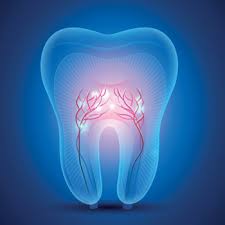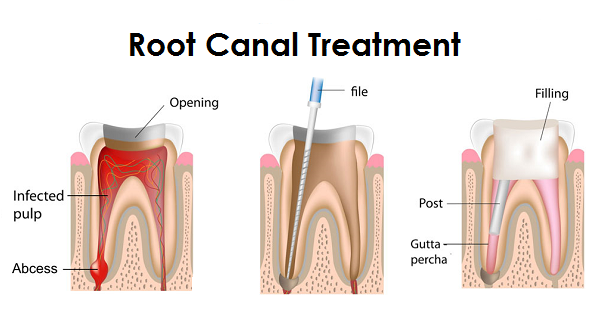Save a tooth that would otherwise be lost using safe and biocompatible materials
Why Root Canal Therapy?
Root canals are solely performed only when the only alternative is to extract the tooth. The following is a list of some of the reasons root canal therapy may be indicated.
- Tooth that has decayed or fractured deep into the nerve
- Worsening pain from contact with hot or cold liquids
- Pain when biting down or pushing on a tooth
- Pain that is constant, throbbing and/or aching
- Swollen gum area, side of face, or bad taste in mouth
- A pimple on the gum that releases pus or blood
- Radiating pain from one area of the mouth to another
- Loss of sleep due to pain in a tooth
- Consistent pain and sensitivity after a filling that required extensive removal of the tooth structure

What is Root Canal Therapy?
Inside each tooth is a canal(s) that contains the pulp (nerve and blood supply) for the tooth. When the pulp becomes infected due to decay or injury, it must be removed from the canals of each root. If left untreated, an abscess can form and severe pain and swelling can occur. Once the infected pulp is removed and the infection eliminated, the canals are filled with an inert, medicated material to seal it and prevent the return of the infection.
All back teeth and some front teeth that have had root canal therapy must be protected with a crown. The crown in needed because removal of the pulp in teeth cause that tooth to become brittle and more susceptible to fracture. The crown protects and strengthens the susceptible tooth and prevents fracture.
How Are Root Canals Performed?
During a root canal procedure the tooth is numbed under local anesthesia. A latex-free rubber dam is inserted in to the patients mouth to keep the inside of the tooth sterile during the procedure and to protect the patient from the small instruments that are used during the procedure. The tooth is gentle opened to expose the infected and degenerating pulp (nerve) inside the tooth. Small instruments called files are carefully inserted in to the tooth to ensure the removal of all the infected tissue. These small files are able to traverse the nerve all the way to the end of the root. This small space is called the canal and the number of canals varies depending on which tooth is being treated. After the infected pulp tissue is removed and the nerve canals are cleaned a biocompatible sealing material called gutta percha is inserted in to the nerve canal space to seal it and to prevent the colonization of bacteria. After the root canal is completed generally a crown is placed over the tooth to protect it long term.

The benefits of Root Canal Therapy:
Root canal therapy is the only treatment that can save a tooth that would otherwise die and need to be removed. Root canal therapy also gets rid of the pain and infection in the tooth that can be caused by large cavities, injury or trauma to the tooth. Over 98% of root canals are successful and enable the tooth to be retained indefinitely.
Are there other treatment options?
The only real alternative is to remove the tooth. However, this typically will require a bridge or dental implant to replace the missing tooth. These solutions will ultimately cost more than the root canal therapy and will usually not attain the results possible by keeping the natural tooth.
